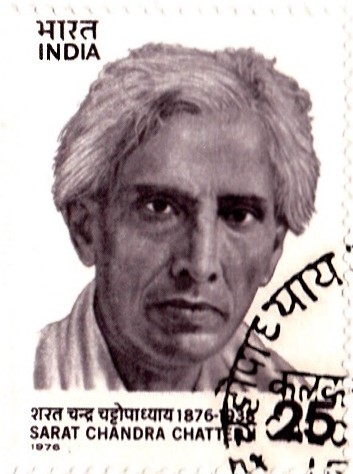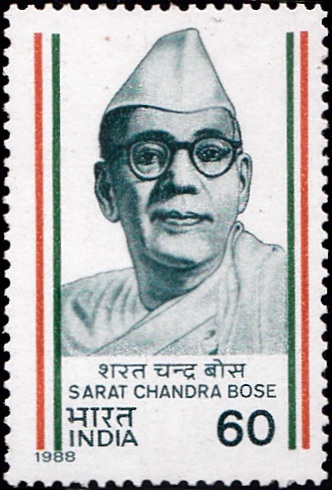
Satish Chandra Samanta
A commemorative postage stamp on Satis Chandra Samanta, known for his leadership for Tamralipta Jatiya Sarkar (Tamrlipta National Government) in Tamluk during 1942 Quit India Movement :

 Issued by India
Issued by India
Issued on Sep 29, 2001
Issued for : The Department of Posts is happy to issue a postage stamp in honour of this selfless leader whose devotion to public service has had few parallels.
Credits :
Stamp & FDC : Layout by Alka Sharma, based on material furnished by the sponsors
Cancellation : Alka Sharma
Type : Stamp, Mint Condition
Colour : Four Colour
Denomination : 400 Paise
Overall size : 2.90 x 3.91 Cms.
Printing Size : 2.54 x 3.55 Cms.
Perforation : 13 x 13
Paper : Imported un w/m stamp paper
Stamps Printed : 0.4 million
Number per issue sheet : 40
Printing Process : Photo Offset
Printer : Eagle Press Pvt. Ltd.
Name : Satish Chandra Samanta
Born on Dec 15, 1900 at Mahishadal, Purba Medinipur district, West Bengal, India
Died on Jun 4, 1983 at Mahishadal, Purba Medinipur district, West Bengal, India
About :
- A veteran freedom fighter and an immensely popular leader from West Bengal, Satis Chandra Samanta (1900-1983) lived a life of sacrifice and renunciation in the service of the country.
- Courage, maturity and sympathy for the deprived were evident in Satis‘ character at a young age. He had to go through the agony of losing his mother in his infancy, but was quick to come to terms with reality. Teachings of his Guru, Swami Pragnanananda Saraswati, with whom he came into contact at the age of fifteen, had a life-long influence on him. The young Satis decided to adopt Brahmacharya as advised by his Guru, and also chose the path of service to humanity as the mission of his life. He was a second year student in the Shibpur Engineering College when he decided to forsake his studies in favour of working for the freedom of the motherland.
- Satis Chandra Samanta started his public life through the activities organised by the Indian National Congress in his locality. He went on to become the President of the Tamluk Congress Committee and remained a dedicated Congress worker for many decades. However, he was above party politics and was respected by one and all. His unlimited energy and leadership qualities proved to be a big asset in organising constructive work simultaneously with the activities of the freedom struggle. He would organise and lead by example activities like cleaning the roads and choked up ponds to prevent malaria, nursing cholera patients, organising free medical camps, training volunteers and spreading education and literacy in backward areas.
- Satis Chandra Samanta is remembered most for his leadership of the National Government called Tamralipta Jatiya Sarkar which was formed in Tamluk in the wake of the Quit India Movement. In the face of the atrocities unleashed by the British government, the people of Tamluk decided that for the removal of anarchy and to establish peace and order, it was essential to form their own Government. Satis Chandra Samanta was the automatic choice to lead the Government and was virtually enthroned as the Sarbhadhinayak (Dictator) of the National Government. From the formation of National Government on 17 December 1942 till his arrest in June 1943, he oversaw its functioning, ensuring that the administration was discharged in an effective and fair manner.
- In post-independence India, Satis Chandra Samanta was a Member of Parliament for almost three decades. He also made substantial contributions to numerous Parliamentary Committees as Member or Chairman.
- Text : Based on material furnished by the sponsors.








[…] Matangini Hazra died. After Matangini the leadership was taken by Ajay Mukherjee, Sushil Dhara, and Satish Samanta and they captured Lalbari. On 17th December 1942 A.D. Ajoy Mukherjee formed the “Tamluk […]